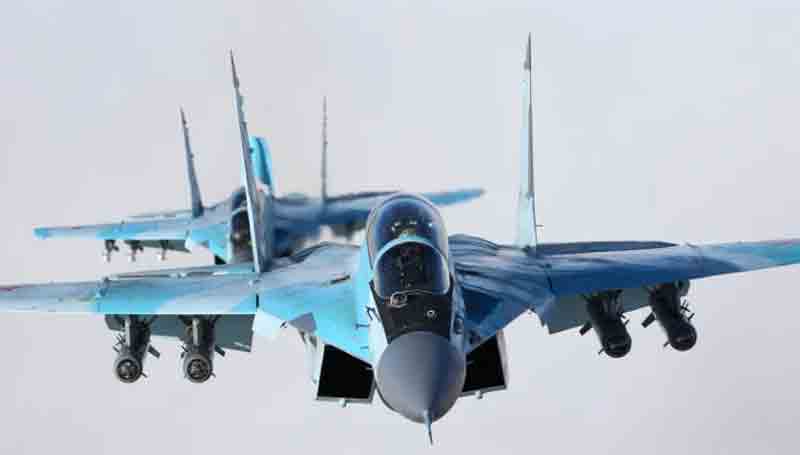On May 1, 2025, the Ukrainian Military Intelligence, referred to as GUR, shared footage via the Clash Report social media account that depicted first-person view (FPV) drone strikes aimed at Russian S-300V air defense systems and their associated radars in Crimea. The operation targeted key components of Russia’s air defense network, including an S-300V launcher, an Obzor-3 radar, Kasta-2E2, ST-68, and Imbir radar systems.
This operation took place in Crimea, a strategically important peninsula that Russia annexed in 2014, highlighting a significant challenge for contemporary militaries: the susceptibility of costly, advanced ground-based systems to inexpensive, nimble drones. These strikes not only have immediate tactical consequences for the ongoing conflict but also provoke critical discussions about the future of warfare, where asymmetric technologies could disrupt established military hierarchies.
It raises the question of why systems designed to counter sophisticated threats are faltering against drones that are a fraction of their cost, and what implications this has for global defense strategies. The emergence of FPV drones marks a transformative change in combat methods.
Initially created for civilian racing and hobbyist use, these small, camera-equipped unmanned aerial vehicles have been repurposed for military applications with significant impact. Priced between $500 and $2,000, FPV drones come with high-resolution cameras and can carry small explosive payloads, enabling operators to guide them accurately through real-time video feeds.
Their agility, affordability, and ease of production make them particularly effective for targeting high-value assets. In the strikes in Crimea, Ukrainian forces showcased how these drones can infiltrate defended airspace, taking advantage of vulnerabilities in systems designed to counter larger, more conventional threats. The capability of FPV drones to fly at low altitudes, often beneath the detection capabilities of traditional radars, enhances their operational effectiveness.
Reports from previous operations in 2025, as noted by Militarnyi, reveal that Ukrainian drones have consistently targeted Russian radar systems such as the Kasta-2E2 and Podlet, indicating a strategic effort to undermine air defense capabilities. The S-300V, a key component of these systems, serves as a fundamental element of Russia’s air defense framework. Originating from the Soviet era and undergoing continuous enhancements, the S-300 family is engineered to defend against a variety of aerial threats, including ballistic and cruise missiles, as well as aircraft.
The S-300V variant, specifically designed for military units, offers mobile, long-range air defense for ground forces. It features launchers equipped with 9M82 and 9M83 missiles, which can engage targets at distances of up to 100 kilometers and altitudes of 30 kilometers. The system’s radar suite, which includes the 9S15 Obzor-3 for long-range surveillance and the 9S19 Imbir for missile guidance, allows it to track multiple targets at once. The Kasta-2E2, another target of the strikes, is a mobile radar system optimized for detecting low-altitude threats, with a detection range of 150 kilometers and the capability to monitor targets up to 6 kilometers in altitude. The ST-68 radar, utilized for air surveillance, enhances these systems by providing early warning and target acquisition.
Collectively, these elements create a layered defense network that is theoretically capable of countering advanced aerial attacks. However, the strikes in Crimea have exposed significant vulnerabilities within this architecture. Although the S-300V and its radars are mobile, they require time to reposition, rendering them susceptible during setup or when stationary. FPV drones, characterized by their small radar signatures and ability to fly close to the ground, take advantage of these weaknesses. Unlike manned aircraft or larger drones, FPV drones are challenging to detect until they are alarmingly close. Traditional countermeasures, such as electronic warfare systems, also face difficulties against drones that utilize fiber-optic guidance or jam-resistant communication channels.
A report from Militarnyi in January 2025 emphasized Ukraine’s initiatives to combat Russian fiber-optic drones, revealing that both parties are adjusting to this emerging threat. The economic contrast is significant: an S-300V launcher costs tens of millions of dollars, whereas a drone capable of neutralizing it can be produced at a much lower cost. This imbalance enables smaller forces to deliver disproportionate damage, a strategy that Ukraine has honed during the conflict.
The susceptibility of ground-based systems is not exclusive to Russia. In 2020, Azerbaijan effectively utilized Turkish Bayraktar TB2 drones against Armenian armored units and air defenses in Nagorno-Karabakh, illustrating how unmanned systems can dominate conventional forces. Likewise, Houthi rebels in Yemen have deployed inexpensive drones to strike Saudi Arabia’s Patriot systems, which, similar to the S-300, are designed to counter high-altitude threats.
The U.S. military has encountered comparable issues, with reports from 2019 highlighting drone breaches over restricted airspace in Ohio and New Jersey, revealing vulnerabilities in domestic air defenses. These occurrences highlight a widespread challenge: military equipment developed for Cold War-era conflicts is poorly suited to address the rise of low-cost, widely available technologies. The Pentagon has recognized this issue, investing in counter-drone technologies such as the Coyote interceptor and laser-based defense systems, although these are still in the initial phases of implementation.
In Crimea, the loss of S-300V components and radar systems carries immediate strategic consequences. The region is crucial for Russia’s Black Sea Fleet and air operations, making strong air defenses vital.
The elimination of radars such as the Kasta-2E2 and Imbir results in gaps within Russia’s surveillance framework, potentially enabling Ukrainian missiles or larger drones to launch attacks with reduced opposition. A report from Euromaidan Press in March 2025 cited aviation expert Valerii Romanenko, who indicated that similar assaults had ‘effectively dismantled’ Crimea’s air defense capabilities, revealing weaknesses throughout the area.
The psychological ramifications are also considerable. Successful drone attacks undermine trust in Russia’s highly promoted air defense systems, which have been advertised worldwide as nearly invulnerable. Nations like India and China, which utilize S-300 variants, may now reconsider their dependability against contemporary threats. Historically, air defense systems have found it challenging to adapt to advancing threats.
During the 1991 Gulf War, Iraq’s Soviet-supplied air defenses were outmatched by U.S. stealth aircraft and precision-guided munitions. In 2019, a drone and missile strike on Saudi Arabia’s Abqaiq oil facility, attributed to Iran, circumvented sophisticated Patriot systems, resulting in considerable damage. These instances underscore a persistent issue: air defenses tend to be reactive, built to address known threats rather than anticipating emerging ones.
The emergence of FPV drones intensifies this dilemma, compelling military forces to reevaluate their strategies. Russia has reacted by deploying short-range systems like the Pantsir-S1, which has also been targeted in previous Ukrainian attacks, yet even these have shown vulnerabilities. A Defense Express report from June 2023 highlighted that 18 Pantsir systems had been destroyed in Ukraine, frequently by the drones they were designed to counter.
The wider consequences of these strikes reach far beyond the combat zone. The democratization of drone technology has made it easier for non-state actors and smaller nations to access these tools. Organizations like ISIS have utilized commercial drones to deploy explosives in Iraq and Syria, while Iran has provided drones to its proxies throughout the Middle East. This spread of technology poses a challenge to the supremacy of conventional military powers, which have heavily invested in large, costly platforms.
For example, the U.S. allocates billions to systems like the F-35, yet it faces threats from drones that can be constructed in personal workshops. In response, NATO nations are investigating new technologies, including directed-energy weapons and AI-based counter-drone systems. A 2023 RAND study indicated that laser weapons could effectively neutralize drone swarms at a lower cost, but the challenge remains to scale these systems for use in combat.
Ukraine’s achievements with FPV drones can be attributed in part to its innovative ecosystem. Crowdfunding initiatives, as noted by Defense Express in 2023, have allowed civilians to provide drones to the military, enhancing state efforts. This grassroots strategy stands in contrast to Russia’s more centralized procurement process, demonstrating how flexibility can outperform sheer scale.
The Katran X1 naval drone from Ukraine, which may have played a role in the Crimea strikes by serving as a relay platform, illustrates this adaptability. According to a March 2025 article from Defense Express, the Katran X1 is capable of carrying multiple FPV drones, increasing their operational range and facilitating strikes deep within Russian-controlled areas. This integration of maritime and aerial drones highlights the changing dynamics of combined arms warfare, where low-cost systems enhance the effectiveness of traditional military forces.
The strikes in Crimea signify a notable change in military strategy. Ukraine’s approach of neutralizing air defenses prior to executing larger operations, such as the missile attacks on Sevastopol in September 2024, indicates a strategic intent to weaken Russia’s defensive capabilities. This tactic is reminiscent of U.S. military strategies in previous conflicts, where the suppression of enemy air defenses was essential for achieving air dominance.
However, Ukraine is accomplishing this with significantly fewer resources, relying more on creativity than sheer force. According to a report from The War Zone in March 2025, these strikes may be preparing the ground for a more extensive aerial offensive against Russia, although Ukraine’s limited resources make a comprehensive assault on Crimea improbable in the near future.
The implications for global military forces are significant. Investing heavily in centralized systems without adequate counter-drone measures is a risky strategy. The U.S. Army’s Joint Counter-small Unmanned Aircraft Systems Office, created in 2020, is working on developing multi-layered defenses that include electronic jammers and kinetic interceptors.
Nevertheless, as highlighted in a 2024 report by the Government Accountability Office, these initiatives encounter issues related to coordination and scalability. Other countries, such as Israel, have developed sophisticated counter-drone technologies like the Drone Guard, which employs radar and jamming systems to mitigate threats.
However, no system is infallible, and the rapid advancement of drone technology necessitates ongoing adaptation. The events in Crimea encapsulate a broader shift in warfare, illustrating how technology, once exclusive to superpowers, is now within reach of smaller entities, thereby equalizing the battlefield in unforeseen manners.
For Russia, the loss of S-300V systems and radar capabilities represents a tactical disadvantage, but for the global community, it serves as a cautionary tale. Militaries must find a balance between investing in advanced systems and establishing defenses against low-cost threats. Neglecting this balance could lead to obsolescence in an era where a drone priced lower than a smartphone can incapacitate a multimillion-dollar weapon.
Discover more from Defence Talks | Defense News Hub, Military Updates, Security Insights
Subscribe to get the latest posts sent to your email.





